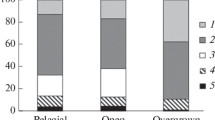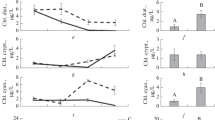Abstract
We assessed the efficiency of the transfer of essential substances (carbon, phosphorus, nitrogen, and fatty acids (FA), including polyunsaturated fatty acids (PUFAs)) from phytoplankton to planktonic crustaceans in experimental mesocosms in the presence and absence of fish. The experiments were conducted under mesotrophic conditions in 300 L mesocosms. We have found that transfer efficiencies from producers to consumers are different for different substances. In particular, FA, including PUFAs, are transferred less efficiently than carbon. In contrast, the efficiency of nutrient transfer, especially phosphorus, is higher than that of carbon. This evidences that zooplankton can accumulate nutrients, increasing their quality as a resource for higher trophic levels. Fish significantly reduced the efficiency of carbon transfer from phytoplankton to zooplankton per unit of water volume, but did not affect the transfer of substances per unit of biomass. Thus, the quality of zooplankton as a food resource for higher trophic levels did not decrease in the presence of fish, despite the decline in the efficiency of the transfer of the essential substances per unit of water volume under their influence. Since the efficiency of essential substances transfered from phytoplankton to zooplankton determines the functioning of the entire trophic web, we should seek ways to increase it.






Similar content being viewed by others
REFERENCES
Alimov, A.F., An Introduction to Production Hydrobiology, Leningrad: Gidrometeoizdat, 1989.
Błędzki, L.A. and Rybak, J.I., Freshwater Crustacean Zooplankton of Europe, Basel, Switzerland: Springer, 2016. https://doi.org/10.1007/978-3-319-29871
Brett, M.T., Muller-Navarra, D.C., Ballantyne, A.P., et al., Daphnia fatty acid composition reflects that of their diet, Limnol. Oceanogr., 2006, vol. 51, p. 2428.
Cohen, Z., Norman, H.A., and Heimer, Y.M., Microalgae as a source of n-3 fatty acids, in Plants in Human Nutrition. World Review of Nutrition and Dietetics, Basel: Karger, 1995, vol. 77, p. 1.
Feniova, I., Sakharova, E., Karpowicz, M., et al., Direct and indirect impacts of fish on crustacean zooplankton in experimental mesocosms, Water, 2019, vol. 11, no. 10. https://doi.org/10.3390/w11102090
Gaevsky, N.A., Kolmakov, V.I., Anishchenko, O.V., and Gorbaneva, T.B., Using DCMU— fluorescence method for identification of dominating phytoplankton groups, J. Appl. Phycol., 2005, vol. 17, p. 483.
Gladyshev, M.I., Sushchik, N.N., Kolmakova, A.A., et al., Seasonal correlations of elemental and ω3 PUFA composition of seston and dominant phytoplankton species in a eutrophic Siberian Reservoir, Aquat. Ecol., 2007, vol. 41, p. 9. https://doi.org/10.1007/s10452-006-9040-8
Gladyshev, M.I., Sushchik, N.N., Anishchenko, O.V., et al., Efficiency of transfer of essential polyunsaturated fatty acids versus organic carbon from producers to consumers in a eutrophic reservoir, Oecologia, 2011, vol. 165, p. 5211. https://doi.org/10.1007/s00442-010-1843-6
Gliwicz, Z.M., Ghilarov, A., and Pijanowska, J., Food and predation as major factors limiting two natural populations of Daphnia cucullata Sars, Hydrobiologia, 1981, vol. 80, p. 205. https://doi.org/10.1007/BF00018359
Gulati, R. and DeMott, W., The role of food quality for zooplankton: remarks on the state-of-the-art, perspectives and priorities, Freshwater Biol., 1997, vol. 38, pp. 753–768.
Harwood, J.L., Recent advances in the biosynthesis of plant fatty acids, Biochim. Biophys. Acta, 1996, vol. 1301, p. 7.
Heinz, E., Biosynthesis of polyunsaturated fatty acids, in Lipid Metabolism in Plants, Boca Raton: CRC Press, 1993, p. 34.
Hudson, J.J., Taylor, W.D., and Schindler, D.W., planktonic nutrient regeneration and cycling efficiency in temperate lakes, Nature, 1999, vol. 400, p. 659. https://doi.org/10.1038/23240
Ikeda, T., Hirakawa, K., and Shiga, N., Production, metabolism and production/biomass (P/B) ratio of Metridia pacifica (Crustacea; Copepoda) in Toyama Bay, southern Japan Sea, Plankton Biol. Ecol., 2002, vol. 49, no. 2, p. 58.
Kalachova, G.S., Gladyshev, M.I., Sushchik, N.N., and Makhutova, O.N., Water moss as a food item of the zoobenthos in the Yenisei River, Centr. Eur. J. Biol., 2011, vol. 6, p. 236. https://doi.org/10.2478/s11535-010-0115-0
Karpowicz, M., Feniova, I., Gladyshev, M.I., et al., The stoichiometric ratios (C:N:P) in a pelagic food web under experimental conditions, Limnologica, 2019, vol. 77, p. 125690. https://doi.org/10.1016/j.limno.2019.125690
Kolmakov, V.I., Role of Microcystis aeruginosa passing through the digestive tracts of filter-feeding animals in eutrophic water reservoirs (review), Contemp. Probl. Ecol., 2014, vol. 7, p. 455. https://doi.org/10.1134/S1995425514040052
Kolmakov, V.I. and Gladyshev, M.I., Growth and potential photosynthesis of cyanobacteria are stimulated by viable gut passage in crucian carp, Aquat. Ecol., 2003, vol. 37, p. 237.
Kolmakov, V.I., Anishchenko, O.V., Ivanova, E.A., et al., Estimation of periphytic microalgae gross primary production with DCMU-fluorescence method in Yenisei River (Siberia, Russia), J. Appl. Phycol., 2008, vol. 20, pp. 289–297. https://doi.org/10.1007/s10811-007-9246-8
Kuz’min, G.V., Phytoplankton, in Metodika izucheniya biogeotsenoza vnutrennikh vodoemov (Methods for Studying the Biogeocenosis of Inland Water Bodies), Moscow: Nauka, 1975, p. 73.
Lacroix, G., Biomass and production of plankton in shallow and deep lakes: are there general patterns?, Ann. Limnol., 1999, vol. 35, no. 2, p. 111.
Lands, W.E.M., Human life: caught in the food web, in Lipids in Aquatic Ecosystems, New York: Springer, 2009, p. 327.
Lindeman, R.L., The trophic-dynamic aspect of ecology, Ecology, 1942, vol. 23, p. 399.
Mikheeva, T.M., Methods of quantitative estimates of nanophytoplankton (review), Hydrobiol. J., 1989, vol. 25, p. 3.
Müller-Navarra, D.C., Evidence that a highly unsaturated fatty acid limits daphnia growth in nature, Arch. Hydrobiol., 1995, vol. 132, pp. 297–307.
Murphy, J. and Riley, J.P., A modified single solution method for the determination of phosphate in natural waters, Anal. Chim. Acta, 1962, vol. 27, p. 31.
Pauly, D. and Christensen, V., Primary production required to sustain global fisheries, Nature, 1995, vol. 374, p. 255.
Schoo, K.L., Malzahn, A.M., Krause, E., and Boersma, M., Increased carbon dioxide availability alters phytoplankton stoichiometry and affects carbon cycling and growth of a marine planktonic herbivore, Mar. Biol. (Berlin), 2013, vol. 160, p. 2145. https://doi.org/10.1007/s00227-012-2121-4
Schulz, M., Koschel, R., Reese, C., and Mehner, T., Pelagic trophic transfer efficiency in an oligotrophic, dimictic deep lake (Lake Stechlin, Germany) and its relation to fisheries yield, Limnologica, 2004, vol. 34, p. 264.
Semenchenko, V.P., Razlutskij, V.I., Feniova, I.Yu., and Aibulatov, D.N., Biotic relations affecting species structure in zooplankton communities, Hydrobiologia, 2007, vol. 579, no. 1, p. 219. https://doi.org/10.1007/s10750-006-0411-x
Slobodkin, L.B., On the inconstancy of ecological efficiency and the form of ecological theories, in Growth by Intussusception: Ecological Essays in Honor of G. Evelyn Hutchinson, Hamden, CT: Archon Books, 1972.
Sommer, U. and Sommer, F., Cladocerans versus copepods: the cause of contrasting top-down controls on freshwater and marine phytoplankton, Oecologia, 2006, vol. 147, p. 183. https://doi.org/10.1007/s00442-005-0320-0
Sterner, R.W. and Hessen, D.O., Algal nutrient limitation and the nutrition of aquatic herbivores, Annu. Rev. Ecol. Syst., 1994, vol. 25, p. 1.
Stockwell, J.D. and Johannsson, O.E., Temperature-dependent allometric models to estimate zooplankton production in temperate freshwater lakes, Can. J. Fish. Aquat. Sci., 1997, vol. 54, p. 2350. https://doi.org/10.1139/f97-141
Tocher, D.R., Sargent, J.R., and Frerichs, G.N., The fatty acid compositions of established fish cell lines after long-term culture in mammalian sera, Fish Physiol. Biochem., 1988, vol. 5, p. 219.
Uttaro, A.D., Biosynthesis of polyunsaturated fatty acids in lower eukaryotes, IUBMB Life, 2006, vol. 58, p. 563. https://doi.org/10.1080/15216540600920899
Vinberg, G.G., Metody opredeleniya produktsii presnovodnykh zhivotnykh (Methods for Determining the Production of Freshwater Animals), Minsk: Vysheishaya shkola, 1968.
Vinberg, G.G. and Lavrenteva, G.M., Guidelines for the collection and processing of materials for hydrobiological studies in freshwater bodies, in Phytoplankton and Its Products, Leningrad: Gosniorkh USSR, 1982, p. 1.
Yacobi, Y.Z. and Zohary, T., Carbon: chlorophyll a ratio, assimilation numbers and turnover times of Lake Kinneret phytoplankton, Hydrobiologia, 2010, vol. 639, p. 185. https://doi.org/10.1007/s10750-009-0023-3
Funding
The collection of biological material and experimental studies were supported by the Polish National Science Centre (project no. UMO-506 2016/21/B/NZ8/00434). Phytoplankton samples were processed with support from the Russian Foundation for Basic Research (project no. 18-54-00002 Bel_a), zooplankton samples were processed and analyzed using the Belarusian Republican Foundation for Fundamental Research (project no. BRFFR no. B18R-004), and statistical data analyses were conducted as part of State Task no. AAAA-A18-118012690096-1. The interpretation of the results, review of the literature, and preparation of materials for publication were funded by the Russian Science Foundation (project no. 16-14-10323).
Author information
Authors and Affiliations
Corresponding author
Ethics declarations
Conflict of interests. The authors declare that they have no conflicts of interest.
Statement on the welfare of animals. All applicable international, national, and/or institutional guidelines for the care and use of animals were followed.
Additional information
Translated by I. Feniova
Abbreviations: Bcrust, crustacean biomass; Bphyto, phytoplankton biomass; SP, secondary production (crustacean production); DHA, docosahexaenoic acid; FAs, fatty acids; PUFAs, polyunsaturated fatty acids; PP, primary production; and EPA, eicosapentaenoic acid.
Rights and permissions
About this article
Cite this article
Feniova, I.Y., Sakharova, E.G., Buseva, Z.F. et al. Efficiency of Transfer of Essential Substances from Phytoplankton to Planktonic Crustaceans in Mesotrophic Conditions. Inland Water Biol 14, 49–59 (2021). https://doi.org/10.1134/S1995082920040033
Received:
Revised:
Accepted:
Published:
Issue Date:
DOI: https://doi.org/10.1134/S1995082920040033




